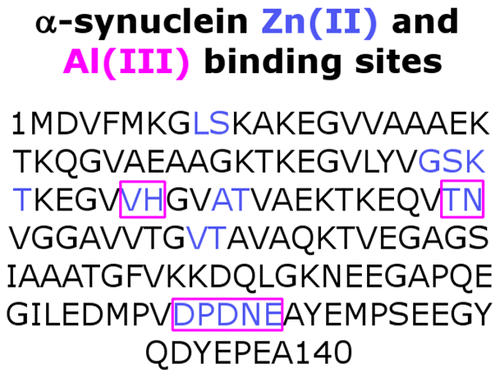当前位置:
X-MOL 学术
›
J. Phys. Chem. A
›
论文详情
Our official English website, www.x-mol.net, welcomes your
feedback! (Note: you will need to create a separate account there.)
A Systematic DFT Study of Some Plausible Zn(II) and Al(III) Interaction Sites in N-Terminally Acetylated α-Synuclein
The Journal of Physical Chemistry A ( IF 2.7 ) Pub Date : 2018-01-04 00:00:00 , DOI: 10.1021/acs.jpca.7b10744 Rafael Ramis 1 , Joaquín Ortega-Castro 1, 2 , Bartolomé Vilanova 1, 2 , Miquel Adrover 1, 2 , Juan Frau 1, 2
The Journal of Physical Chemistry A ( IF 2.7 ) Pub Date : 2018-01-04 00:00:00 , DOI: 10.1021/acs.jpca.7b10744 Rafael Ramis 1 , Joaquín Ortega-Castro 1, 2 , Bartolomé Vilanova 1, 2 , Miquel Adrover 1, 2 , Juan Frau 1, 2
Affiliation

|
The interactions between the protein α-synuclein and the Zn(II) and Al(III) cations at different sites were studied at the M06/6-311+G(d,p)/SMD and the ωB97X-D/6-311+G(d,p)/SMD levels of theory. For Zn(II), previous experimental studies determined the presence of a high affinity site at Asp121 and a lower affinity one at His50. As for Al(III), an in vitro study showed it to be the most effective cation to induce structural changes in α-synuclein and to accelerate its aggregation. Besides Zn(II) and Al(III), Cu(II) also binds α-synuclein (in fact, its complexes are the most studied and the best characterized ones) forming square planar complexes, and several binding sites are known for it, involving Met1-Asp2 (only in nonacetylated α-synuclein), His50, and Asp121. Herein, we applied a simple theoretical methodology, which satisfactorily reproduces experimental geometries and energies for complexes of N-terminally acetylated α-synuclein with Cu(II), to study Zn(II) and Al(III) complexes at those same sites, as well as at some structurally analogous alternative sites. We found binding geometries for Zn(II) and Al(III) that differ from the ones for Cu(II). These results can help to understand the interactions between α-synuclein and metals, one of the factors leading to the formation of potentially neurotoxic α-synuclein aggregates.
中文翻译:

系统的DFT研究N末端乙酰化的α-突触核蛋白中一些可能的Zn(II)和Al(III)相互作用位点
在M06 / 6-311 + G(d,p)/ SMD和ωB97X-D/ 6-311上研究了蛋白质α-突触核蛋白与不同位点的Zn(II)和Al(III)阳离子之间的相互作用+ G(d,p)/ SMD理论水平。对于Zn(II),先前的实验研究确定在Asp121处存在高亲和力位点,在His50处存在较低的亲和力位点。至于Al(III),一项体外研究表明它是诱导α-突触核蛋白结构改变并加速其聚集的最有效阳离子。除了Zn(II)和Al(III),Cu(II)还与α-突触核蛋白结合(实际上,它的复合物是研究最多,表征最好的复合物),形成方形平面复合物,并且它的几个结合位点是已知的,涉及Met1-Asp2(仅在非乙酰化的α-突触核蛋白中),His50和Asp121。在这里,我们应用了一种简单的理论方法,可以令人满意地重现N末端乙酰化的α-突触核蛋白与Cu(II)的配合物的实验几何形状和能量,以研究相同位置以及某些结构相似的替代位置的Zn(II)和Al(III)配合物。我们发现与Cu(II)不同的是Zn(II)和Al(III)的结合几何形状。这些结果可以帮助理解α-突触核蛋白与金属之间的相互作用,这是导致潜在的神经毒性α-突触核蛋白聚集体形成的因素之一。
更新日期:2018-01-04
中文翻译:

系统的DFT研究N末端乙酰化的α-突触核蛋白中一些可能的Zn(II)和Al(III)相互作用位点
在M06 / 6-311 + G(d,p)/ SMD和ωB97X-D/ 6-311上研究了蛋白质α-突触核蛋白与不同位点的Zn(II)和Al(III)阳离子之间的相互作用+ G(d,p)/ SMD理论水平。对于Zn(II),先前的实验研究确定在Asp121处存在高亲和力位点,在His50处存在较低的亲和力位点。至于Al(III),一项体外研究表明它是诱导α-突触核蛋白结构改变并加速其聚集的最有效阳离子。除了Zn(II)和Al(III),Cu(II)还与α-突触核蛋白结合(实际上,它的复合物是研究最多,表征最好的复合物),形成方形平面复合物,并且它的几个结合位点是已知的,涉及Met1-Asp2(仅在非乙酰化的α-突触核蛋白中),His50和Asp121。在这里,我们应用了一种简单的理论方法,可以令人满意地重现N末端乙酰化的α-突触核蛋白与Cu(II)的配合物的实验几何形状和能量,以研究相同位置以及某些结构相似的替代位置的Zn(II)和Al(III)配合物。我们发现与Cu(II)不同的是Zn(II)和Al(III)的结合几何形状。这些结果可以帮助理解α-突触核蛋白与金属之间的相互作用,这是导致潜在的神经毒性α-突触核蛋白聚集体形成的因素之一。











































 京公网安备 11010802027423号
京公网安备 11010802027423号